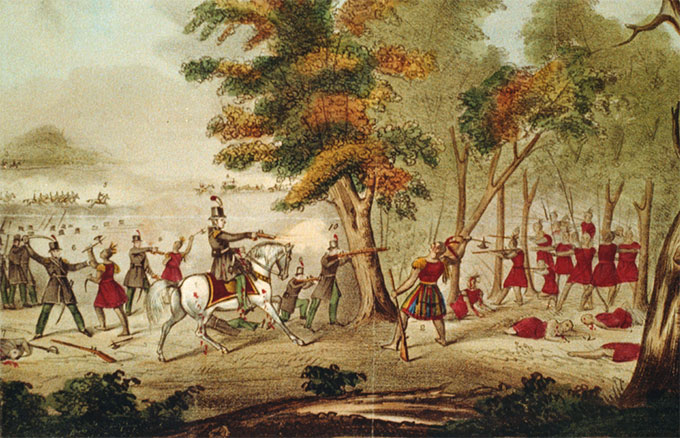Shooting Star
by Mason Winfield

The Battle of the Thames, Chatham, Ontario (just east of Detroit), October 5, 1813
The American Army of the Northwest lost ground and water on the northern frontier in 1812. It spent most of 1813 trying to recover them. A single stroke changed everything. Though the Battle of Lake Erie (September 10, 1813) involved two tiny fleets—nine American ships and six British ones—control of the inland ocean was a game-changer. Suddenly it was the Americans who could feed or choke forts. It was the Americans who could drop armies wherever they wanted.
Pressured by his Native allies to do something, British Major General Henry Procter stayed with his beleaguered forts at Detroit and Amherstburg till the only move left—heading on foot toward home base in Ontario—was a bad one. His Native allies stuck with him, including the unforgettable Tecumseh (1768-1813).
Tecumseh, whose name means “Shooting Star” (possibly, “Leaping Panther”), grew up in the Scioto River valley near Chillicothe, OH. His Shawnee people were Algonquin speakers whose ancestors may have been the mysterious mound-builders.
Tecumseh grew up around turmoil. His father and brothers were killed by whites in his boyhood. At 16 he stoically watched a white man burned alive, jumped up at the end, and vowed never to tolerate such a spectacle again. As a chief, he forbade atrocities.
Tall for his era—five feet, 10 inches—Tecumseh was striking. Whites who met him thought him the finest figure of a man they had ever seen and could envision him founding an empire like those in Mexico, the Yucatan, or the Andes. He nearly married a young white woman, Rebecca Galloway, who taught him English, the Bible, and Shakespeare. (Hamlet was his favorite.) His own people treated him “like a god.” Once a little white girl escaped the ravage of her home and fled to Tecumseh. Tecumseh outraced his posse, wordlessly approached the marauders, and killed the closest with a tomahawk. The others bristled weapons. Dogs, he snarled, I am Tecumseh! They bowed heads.
Tecumseh recognized American expansion into the Louisiana Purchase as a threat to all Native Americans and formed a Native alliance to stop it. Set back in 1811 by William Henry Harrison (1773-1841) at the Battle of Tippecanoe, his coalition threw in with the British in 1812, which seemed the best bet to keep its lands. By October 1813, saving Procter’s redcoated hide—and his army—looked like the way to hold things together. With incalculable consequences for the Niagara war, this force and its inspiring Shawnee chief were on their way to Upper Canada.
American strike forces under future president Harrison landed on the north side of the lake and cut them off near Chatham, Ontario, just east of Detroit. Surely the Americans were licking their chops. Ambushing redcoats backpacking in the woods was a lot easier than facing them head-on and set-up. (If you’re dueling a bull, pick dodgeball over the tackling drill.) The Battle of the Thames (sometimes “Moraviantown”) was a swampy rumble that disadvantaged all parts of Procter’s largely-Native army. Tecumseh was everywhere, fighting, exhorting, and inspiring, his war-shout soaring like his spirit. Like the Hector of Homer, you could tell where he was by his ki-ai, rallying allies and freezing foes. Exactly what happened to him will never be certain.
Maybe he was shot point blank as he closed with the tomahawk by wounded colonel and future Vice President Richard Mentor Johnson (1780-1850). Maybe he was shot by 64-year-old Kentuckian William Whitley (1749-1813), who, mortally wounded the same day, oddly directed that a macabre keepsake, his own scalp, be sent to his wife back in Ol’ Kaintuck. A body almost certainly not Tecumseh’s was torn apart. Wyandot (Huron) historians remember Tecumseh limping from the battle using a musket for a crutch but dying in the woods, surely wearing to the end the locket with its likeness of the girl who taught him Shakespeare. All anyone knows is that at one moment Tecumseh’s spirit-cry flew among the treetops, then was no more. Tecumseh’s Native coalition faded with it.
His indecision may have frustrated Tecumseh, but Procter’s predecessor was “The Hero of Upper Canada,” an impossible act to follow. At his legendary meeting with Tecumseh before the 1812 battle that had taken Fort Detroit, Major General Sir Isaac Brock (1769-1812) announced to his Shawnee counterpart that he’d come for “some lessons in forest-fighting.” Tecumseh crowed something to the effect of, “You da man!” and set his own warriors howling. The exchange of scarves, the gaudy Shawnee sash for the red British one, made the two brothers of a sort. They impress me as the noblest beings of the northern war. Though real warriors selflessly loyal to their causes, each possessed a humanity surpassing his age and culture and inspired others to rise to it. They’re two of the top ten people in history I would like to have met. What a continent this might have been could they have worked together in peace.
The founder of Haunted History Ghost Walks, Inc., Mason Winfield is the author of 10 books, including Ghosts of 1812 (2009, Western New York Wares), a history of the 1812 war on the Niagara.
blog comments powered by Disqus|
Issue Navigation> Issue Index > v12n37 (Week of Thursday, September 12) > Shooting Star This Week's Issue • Artvoice Daily • Artvoice TV • Events Calendar • Classifieds |









 Current Issue
Current Issue